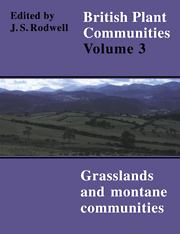Book contents
- Frontmatter
- Contents
- List of Figures
- Preface and Acknowledgements
- Preamble
- Mesotrophic Grasslands
- Community Descriptions
- Calcicolous Grasslands
- Community Descriptions
- Calcifugous Grasslands and Montane Communities
- Community Descriptions
- Index of Synonyms to Grasslands and Montane Communities
- Index of Species in Grasslands and Montane Communities
- Bibliography
CG1 - Festuca Ovina-Carlina Vulgaris Grassland
Published online by Cambridge University Press: 04 July 2020
- Frontmatter
- Contents
- List of Figures
- Preface and Acknowledgements
- Preamble
- Mesotrophic Grasslands
- Community Descriptions
- Calcicolous Grasslands
- Community Descriptions
- Calcifugous Grasslands and Montane Communities
- Community Descriptions
- Index of Synonyms to Grasslands and Montane Communities
- Index of Species in Grasslands and Montane Communities
- Bibliography
Summary
Synonymy
Natural pasture Moss 1907 p.p.; Carboniferous Limestone Grassland Hope-Simpson & Willis 1955 p.p.; Helianthemum apenninum localities Proctor 1956, 1958; Helianthemum canum localities Proctor 1956 p.p.; Helianthemum canum-Thymus drucei Association Proctor 1958 p.p.; Arabis strie ta localities Pring 1961; Carboniferous Limestone Grassland Gittins 1965a p.p.; Thymo-Festucetum Williams & Varley 1967 p.p.; Poterio-Koelerietum vallesianae Shimwell 1968a; Helianthemum apenninum-Euphorbia portlandica Nodum Shim well 1968a; Helianthemo-Koelerietum cristatae Shimwell 1968a p.p.; Draba aizoides localities Kay & Harrison 1970 p.p.; Carboniferous Limestone Grassland Ratcliffe 1977 p.p.; Devonian Limestone Grassland Ratcliffe 1977 p.p.; Typical
Limestone Grassland 3a South Gower Coast Report 1981.
Constant species
Carlina vulgaris, Dactylis glomerata, Festuca ovina, Hieraciumpilosella, Lotus corniculatus, Plantago lanceolata, Sanguisorba minor, Thymus praecox.
Rare species
Arabis stricta, Aster linosyris, Bupleurum baldense, Carex humilis, Cerastium pumilum, Draba aizoides, Euphorbia portlandica, Gentianella anglica, Helianthemum apenninum, H. canum, H. x sulfureum, Hypochoeris maculata, Koeleria vallesiana, Potentilla tabernaemontani, Scilla autumnalis, S. verna, Sedum forsteranum, Senecio cineraria, Veronica spicata, Scorpiurium circinnatum, Tortella nitida.
Physiognomy
The Festuca-Carlina grassland has a characteristically short and open tussocky turf which, even where it forms extensive stands, is usually interrupted by fractured rock outcrops and small patches of bare soil and which is often disposed in more fragmentary fashion over narrow ledges and in crevices. Festuca ovina (or, in one of the sub-communities, F. rubra) is almost always an abundant component of the sward and either Koeleria macrantha or K. vallesiana is also very frequent throughout, though usually in smaller amounts. There are often some rather small tufts of Dactylis glomerata, perhaps of the form variously described as var. abbreviata, var. maritima or ssp. hispanica (see Tutin et al. 1980). Generally, however, it is not perennial grasses but the woody chamaephytes Thymus praecox and Helianthemum spp., together with the deep-rooted hemicryptophyte Sanguisorba minor, which give the vegetation its distinctive stamp. Each of these can be abundant and combinations of them frequently co-dominate with either F. ovina or F. rubra.
Hieracium pilosella and Lotus corniculatus are constant throughout and these, too, may be abundant; Anthyllis vulneraria, though its occurrence is rather more uneven, can also be locally prominent. There are very frequently some scattered rosettes of Plantago lanceolata and, less commonly, Leontodon taraxacoides, Galium verum and Daucus carota (including some records for ssp. gummifer) occur in small quantities. Although many stands occur close to the sea, strictly maritime species are rare in the community as a whole.
- Type
- Chapter
- Information
- British Plant Communities , pp. 126 - 139Publisher: Cambridge University PressPrint publication year: 1992

